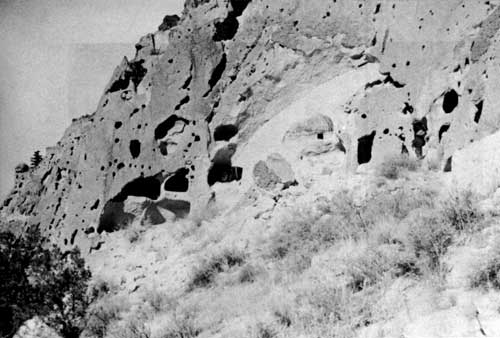|
BANDELIER National Monument |
 |

Group of cave rooms between Long House and
Ceremonial Cave.
Life of the Early People at Bandelier
SHELTER. With his food needs taken care of, the new Frijoles resident thought next of shelter from the weather. Either he organized with some of his neighbors to construct a masonry dwelling in the traditional style of the west country, or he took shelter in a natural cave of the tuff cliff. In the latter case, a few days of scraping and chipping at the soft rock would normally suffice to level off the floor and raise the ceiling; final trimmings, such as fireplace and rocked-up doorway, could be completed at leisure. As years passed and the family grew, it may be assumed that the sooty cave became crowded and was supplemented with rooms in front, built up from rock fragments lying close by, mortared together with adobe from down the slope. For ceiling beams, pinyons and junipers were large enough, since the span needed to be only 6 or 8 feet; even these small timbers were hard enough to cut and trim with a stone axe. Above the beams, small sticks, mostly willow, were tightly laid, then grass or bark was spread to take the final layer of earth which weatherproofed the ceiling, or which made the floor for the room above. The design of the ceilings in the modern buildings at monument headquarters is of this type, a style of Pueblo architecture, largely derived from ancient Indian models, which is commonly seen throughout the Southwest.
It is uncertain which type of construction is the older—the talus house or the open pueblo on the canyon floor. But one thing is evident—a building of the size of Tyuonyi, previously described, was worked on and occupied by scores of families. In troubled times, this massive structure would have served better for mutual defense than scattered or smaller houses.
The rock of which the Bandelier masonry walls were made is not an easy material to build with. Unlike sandstone or even limestone, it refuses to fracture into clean straight lines or right angles. To employ it as building stone, the Indians had to find small miscellaneous blocks and chip these odd pieces into some semblance of usable shape. This chipping or pecking was done with hammerstones and axes of harder lava. The work required to fashion the walls of Tyuonyi, crude though they are, must have been prodigious.

|

|
|
Last Modified: Sat, Jan 6 2001 10:00:00 am PDT |


